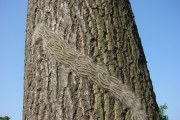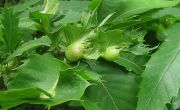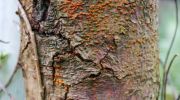RHS and Defra call on the public to become citizen scientists
The Royal Horticultural Society (RHS), Defra, APHA and Forest Research are asking the public to help monitor sweet chestnut trees for known problems and diseases to help map the spread of organisms new to the UK, launching during this year’s National Plant Health Week.
Sweet chestnut trees (Castanea sativa) are some of our most iconic street trees, also found in parks and woods across the country, providing food and a habitat for a diverse range of wildlife.
Two devastating problems
Unfortunately, the health of these trees is facing a growing threat from two devastating problems: the oriental chestnut gall wasp (OCGW) and a fungus, chestnut blight.
To tackle this issue, the organisations are asking the public to become citizen scientists and check a sweet chestnut tree where they live, reporting any signs of disease or where the trees are healthy.
Getting involved in the project is easy and doesn’t require any specialist knowledge.
To get involved with the project just a few simple steps are needed:
- Make sure you know how to identify a sweet chestnut tree
- When you see a sweet chestnut, look for signs of sweet chestnut blight or oriental chestnut gall wasp
- Take photos of the tree and any symptoms of OCGW or chestnut blight
- Go to Tree Alert, the official government reporting tool for tree health, and fill in a report
Signs to look out for include distorted leaves or buds with swellings (galls), a sparse crown and sunken, cracking or discoloured bark. Please visit the RHS website for full details.
National map of the health of sweet chestnut trees
The public are encouraged to report healthy trees, showing no signs or symptoms of OCGW or chestnut blight. Together with reports of OCGW and chestnut blight, this will inform Forest Research scientists of where affected trees are, as well as the proportion being affected.
The data will be used to create a national map of the health of sweet chestnut trees across Britain, which will be invaluable for targeting future surveillance efforts and showing where current efforts protect trees are working. The process will also support efforts to monitor new or emerging threats to all tree health.
The threats posed by chestnut gall wasp and chestnut blight are significant. The OCGW lays its eggs inside the tree’s buds, causing abnormal growths, known as galls, which can stunt the tree’s growth and reduce its ability to produce nuts.
A major threat to the health of sweet chestnut trees.
Chestnut blight is a fungal disease that causes cankers on the tree’s bark and can eventually kill the tree. Both diseases are spreading across Europe and pose a major threat to the health of sweet chestnut trees.
Nicola Spence, UK Chief Plant Health Officer, said: “Sweet chestnut trees – like many other plant and tree species – are increasingly vulnerable to pests and diseases.
“Encouraging the public to be good plant health citizens and report disease sightings is absolutely crucial if we are to minimise the risk to our cherished treescapes.”
Dr Jassy Drakulic, RHS Plant Pathologist, added: “The Check a Sweet Chestnut project is a vital tool in the fight to protect tree health and provides a great opportunity for members of the public to get involved in conservation efforts. By working together to record and monitor these trees we are helping safeguard Britain’s sweet chestnut trees for future generations to enjoy.”
Berkshire, South Cambridgeshire and Norfolk,
The Check a Sweet Chestnut project previously ran in 2021 with partners including the RHS and Universities from across Europe, acting as a successful case study on tree health reporting by the public. Records from citizen scientists mapped 350 sweet chestnut trees in Britain and helped show that OCGW had reached Berkshire, South Cambridgeshire and Norfolk, where no records previously existed.
The organisations are launching the project to coincide with National Plant Health Week (NPHW), 8-14 May 2023. NPHW is a collaborative effort by over 30 organisations to raise awareness of plant health and actions that everyone can take to keep plants and trees healthy.
For more information on the project please visit www.rhs.org.uk/check-a-sweet-chestnut
Public urged to keep watch as greatest risk period for the tree pest oak processionary moth begins
The Forestry Commission has today (11 May) urged the public to report sightings of oak processionary moth caterpillars. We are now entering the greatest risk period as the caterpillars emerge between June and August to feed before turning into adult moths.
Oak processionary moth, which is a tree pest, was first identified in London in 2006 and has since spread to some surrounding counties in the South East of England. Its caterpillars and their nests contain hairs which can cause itchy rashes, eye and throat irritations, and should not be touched under any circumstances.
Oak processionary moth caterpillars also feed on the leaves of several species of oak trees. This can cause the trees to lose their leaves, negatively impacting their growth, and become more vulnerable to other stresses, like drought.
Andrew Hoppit, Oak Processionary Moth Project Manager, said: “As we enter the greatest risk period for Oak Processionary Moth, it’s important that those living in affected areas understand the health risks so that they can be vigilant when enjoying outdoor spaces.
“The Forestry Commission has a whole host of information online that can be used to identify the moth, simply visit Managing Oak Processionary Moth in England. If you spot the pest, report the sighting via our TreeAlert portal. Alternatively, you can email opm@forestrycommission.gov.uk or call 0300 067 4442.”
A Government programme to manage OPM has been in place since 2012. Over the last five years, £10 million has been invested into oak health, including the management of oak processionary moth, as well as research to develop novel control techniques and new policy responses.
In March, The Forestry Commission announced an update to the operational zones and boundaries to manage the spread of OPM. In response to government surveillance in 2022, the Established Area in which OPM is established, and the Buffer Zone in which an annual programme of OPM management led by the Forestry Commission takes place, were expanded.
Following these changes, there will also be new regulation coming into force on 24 May permitting the movement of large oak trees and trade within the Established area and Buffer zone, provided certain biosecurity requirements and movement restrictions are met. For more information on the new changes visit GOV.UK.
Today’s announcement comes during National Plant Health Week which aims to raise public awareness and engagement on how to keep our plants healthy. By identifying threats such as pests and diseases, we protect the benefits plants provide to the public, to wildlife, the environment and our economy. More information can be found on the Plant Health Action.org website.
How to identify Oak Processionary Moth caterpillars
Nests are typically dome or teardrop-shaped, averaging the size of a tennis ball. They are white when fresh, but soon become discoloured and brown. The caterpillars have black heads and bodies covered in long white hairs which contain proteins which can cause itchy rashes, eye, and throat irritations. They can also occasionally cause breathing difficulties in people and pets, so should not be touched under any circumstances.
For more information, visit ‘Managing Oak Processionary Moth in England’.




